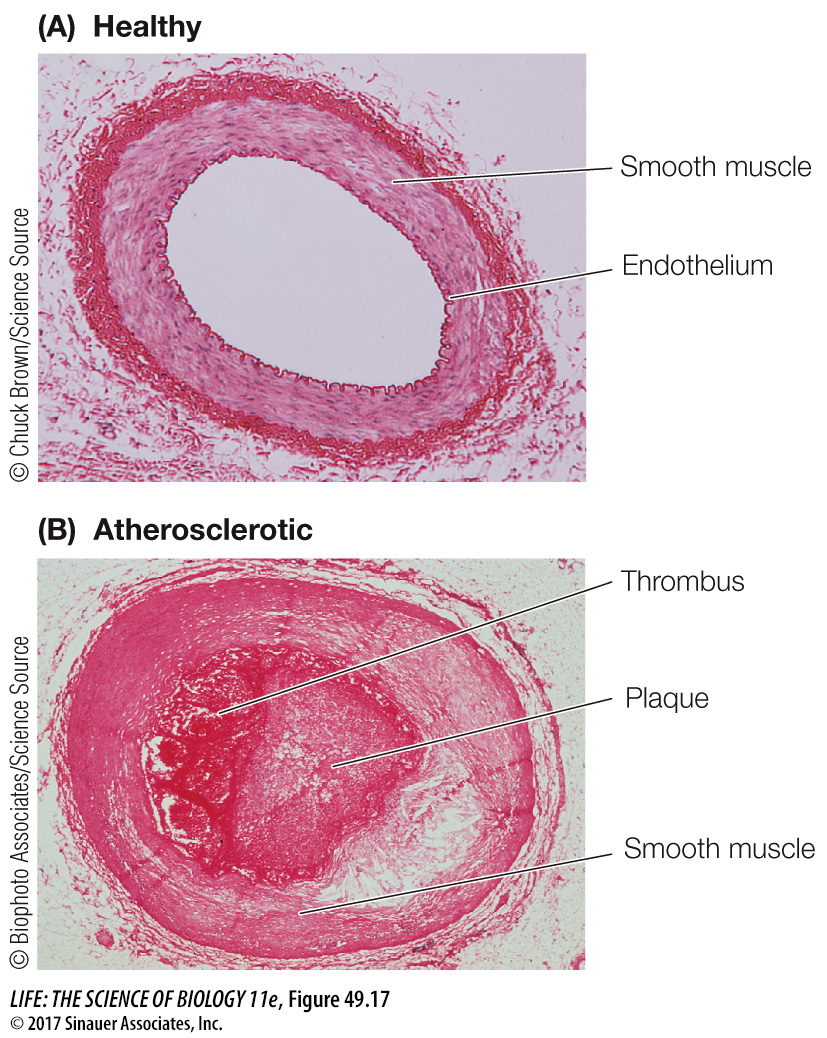Vascular disease is a killer
As mentioned at the beginning of this chapter, cardiovascular disease is responsible for about one-fourth of all deaths each year in the United States, and the same is true in Europe. The immediate cause of most of these deaths is not a defect in heart muscle as in cases of HCM, but is heart attack or stroke—both of which are usually the result of a disease called arteriosclerosis (“hardening of the arteries”) that begins many years before symptoms are detected.
Healthy arteries have a smooth internal lining of endothelial cells (Figure 49.17A) that can be damaged by chronic high blood pressure, smoking, a high-fat diet, or microorganisms. Deposits called plaque begin to form at sites of endothelial damage, initiating an early stage of arteriosclerosis called atherosclerosis. First, the damaged endothelial cells attract certain white blood cells to the site. These cells are then joined by smooth muscle cells migrating from the deeper layers of the arterial wall. Lipids, especially cholesterol, are deposited in these cells, so that the developing plaque becomes fatty. Fibrous connective tissue made by the invading smooth muscle cells in the plaque, along with deposits of calcium, gradually make the artery wall less elastic—hence “hardening of the arteries.” Plaque deposits narrow the artery and causes turbulence in the blood flow. Blood platelets stick to the plaque (see Figure 49.12) and initiate formation of an intravascular blood clot, a thrombus that can block the artery (Figure 49.17B).

Figure 49.17 Atherosclerotic Plaque (A) A healthy, clear artery. (B) An atherosclerotic artery, clogged with plaque and a thrombus.
The blood supply to the heart muscle flows through the coronary arteries, which are highly susceptible to atherosclerosis. As these arteries narrow, blood flow to the heart muscle decreases, causing the symptoms of chest pain and shortness of breath during mild exertion. A person with atherosclerosis is at high risk of forming a thrombus in a coronary artery. This condition, called coronary thrombosis, can totally block the vessel, causing a myocardial infarction (heart attack).
A piece of a thrombus that breaks loose, called an embolus, is likely to travel to and become lodged in a vessel of smaller diameter, blocking its flow (an embolism). Arteries already narrowed by plaque formation are likely places for an embolism. An embolism in an artery in the brain causes the cells fed by that artery to die. This event is a stroke. The specific damage resulting from a stroke, such as memory loss, speech impairment, or paralysis, depends on the location of the blocked artery in the brain.
Important risk factors for developing atherosclerosis are your genetic predisposition and your age. Environmental risk factors also play a large role, however. These include high-fat and high-cholesterol diets, smoking, and a sedentary lifestyle. Certain untreated medical conditions such as hypertension (high blood pressure), obesity, and diabetes are also risk factors for atherosclerosis. For those who have a genetic predisposition to atherosclerosis, it is even more important to minimize environmental risk factors. Changes in diet and behavior and treatment of predisposing medical conditions can prevent and reverse early atherosclerosis and help fend off this silent killer.
